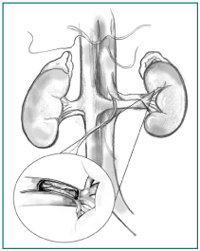Renal artery stenosis pathophysiology: Difference between revisions
No edit summary |
No edit summary |
||
| Line 2: | Line 2: | ||
{{Renal artery stenosis}} | {{Renal artery stenosis}} | ||
{{CMG}} | {{CMG}} {{AE}} {{Shivam Singla}} | ||
==Overview== | ==Overview== | ||
Revision as of 21:24, 4 November 2020
|
Renal artery stenosis Microchapters |
|
Diagnosis |
|---|
|
Treatment |
|
Case Studies |
|
Renal artery stenosis pathophysiology On the Web |
|
American Roentgen Ray Society Images of Renal artery stenosis pathophysiology |
|
Risk calculators and risk factors for Renal artery stenosis pathophysiology |
Editor-In-Chief: C. Michael Gibson, M.S., M.D. [1] Associate Editor(s)-in-Chief: Shivam Singla, M.D.[2]
Overview
The reduction in renal blood flow secondary to renal artery stenosis stimulates renin release from the juxtaglomerular apparatus through activation of the tubuloglomerular feedback, baroreceptor reflex, and the sympathetic nervous system. Elevated angiotensin II activities in turn cause elevation of the arterial pressure and other effects including aldosterone secretion, sodium retention, and left ventricular hypertrophy and remodeling.[1]
Pathophysiology
Renal artery stenosis is a narrowing or blockage of the artery that supplies blood to the kidneys. When the arteries that carry blood to your kidneys become narrow, less blood flows to the kidneys. The macula densa of the kidney senses a decreased systemic blood pressure due to the pressure drop over the stenosis. The response of the kidney to this decreased blood pressure is activation of the renin-angiotension aldosterone system, which normally counteracts low blood pressure, but in this case lead to hypertension (high blood pressure).
The decreased perfusion pressure (caused by the stenosis) leads to decreased blood flow (hypoperfusion) to the kidney and a decrease in the GFR. If the stenosis is long standing and severe the glomerular filtration rate in the affected kidneys never increases again and (pre-renal) renal failure is the result.
